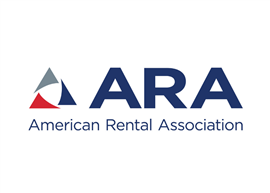Factors affecting US and Canadian rental growth this year
19 August 2024
The American Rental Association (ARA) recently downgraded its forecast for this year, predicting growth to soften to an 8.9% increase in construction, reaching $78.7 billion in 2024. That’s down from its previously upgraded projection in May, in which the organization forecasted a 9.7% increase totaling $79.2 billion, which was 2.8% higher than its February projection of $77.3 billion in rental revenue.
No matter how you slice it, the ARA has been predicting healthy growth all year. But the degree of growth has depended on shifting economic factors, such as speculation over interest rate fluctuations, as well as trends in government spending and home buying.
“The market is still doing well but slowing,” says Scott Hazelton, managing director at S&P Global. “Next year’s GDP growth is lower than trend at 1.6% growth, the trend is around 2.1%. The overall view of rental is positive moving forward, but there is uncertainty out there.”

Kurt Barney, president, Vandalia Rental, Vandalia, Ohio, says, “Largely what we’re seeing is softening growth... We’re seeing pricing elasticity. It’s no longer, ‘Do you have it?’ We’re back to doing business like 2019, when we have to really communicate the value proposition of working with us.”
ARA VP Josh Nickell notes companies that are going head to head with national chains are seeing extra challenges.
“They’re struggling more because supply and demand have stabilized, so being the secondary provider is a little bit more difficult,” he said. “Before, you just showed up and it was good.
“Certain markets are outperforming other markets. mega projects are a big topic of conversation - when they’re going to pick up or if any of them are going to be put on hold. That will have a larger impact on the national rental companies, but it will trickle down to the smaller rental companies too.”
Outlook for Canada
The updated forecast for total Canadian equipment rental revenue shows a 6.6% growth totaling $5.75 billion, compared to last quarter’s projection of 7.2% growth, totaling $5.79 billion.
“What we’re seeing across our markets is pretty slow but Stephenson’s is still growing,” says Rob Wilson, chief operating officer, Stephenson’s Rental Services, Mississauga, Ontario. “It’s a mixed bag. Residential activity represents 60% to 65% of those markets and that activity is down.”
The 2025 projection for Canada’s combined rental revenue is $6.14 billion, a 6.7% year-over-year growth. Broken down by segment that equals $1.14 billion in general tool rental revenue and $5 billion in CIE rental revenue.
“I wouldn’t characterize Canada’s economy as robust, but CIE is one of the strongest investments in particular,” says Hazelton. “We do expect the economy to get stronger as a whole by 2027.”
Strategy matters
Nickell says there’s a lot of question around whether pricing discipline will hold. So far, he says it seems to be.
“People are thinking about used equipment values coming down from record highs. I would say they’re relatively back to normal but how far much further will they go? Fleet availability is improving a lot, that’s an
 Josh Nickell, vice president, American Rental Association (ARA)
Josh Nickell, vice president, American Rental Association (ARA)
obvious bright spot,” he said.
Barney at Vandalia Rental adds, “We’re balancing rate pressures, supply chain and mix of the fleet in a softening environment, especially on the earthmoving side. As interest rates begin to decline, I think it will take some of the projects off the sidelines. The quarter and half points have a huge impact on those projects. The rental model and proposition has never been stronger. It’s a good place to be.”
While that statement might be true, this this is not a time to play fast and loose if you have traditionally been a secondary supplier, Nickell says.
“If supply is catching up, you really don’t want to be that kind of supplier right now,” he says. “You want to be rethinking your fleet mix to match the customer base you can win with.”
Market drivers
What’s driving the latest forecast? S&P Global believes interest rates will not come down until December, despite Federal Reserve Chairman Jerome Powell’s most recent testimony. Powell wants to see inflation stay under control before any moves are made. Hazelton also believes when the cuts come, they will come slowly.
“We [S&P Global] also see a downshift in GDP from 2.4% growth this year to 1.6% growth next year,” says Hazelton.
The upcoming presidential election will play a role in the economy’s performance over the next several months as well, but the long-term effect should be minimal for construction and rental, according to Nickell.
“The general rule of thumb is that election years are tough, uncertainty is not great for the construction industry” he says. “That being said, it usually doesn’t matter what happens. It’s just a question of, is it over and how can we react to the decision that’s been made?
“It often feels like, ‘If this happens or if that happens, things will get better or worse...’ But realistically, the market is pretty good at handling news, but it doesn’t like not knowing. We often see things start to slow down a little bit going into an election cycle. That’s probably pulling on things now, especially in certain markets.”
He adds, “Overall, it would be nice to see interest rates start to come back down.”
STAY CONNECTED



Receive the information you need when you need it through our world-leading magazines, newsletters and daily briefings.
CONNECT WITH THE TEAM






